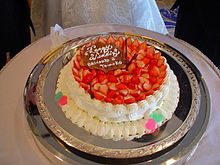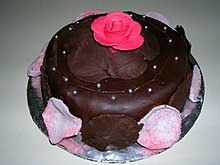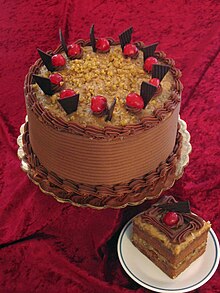| Revision as of 03:17, 14 October 2007 view source75.186.71.186 (talk) →Cake decorating← Previous edit | Revision as of 03:18, 14 October 2007 view source Dbo789 (talk | contribs)Extended confirmed users, Rollbackers946 editsm Reverted 1 edit by 75.186.71.186 identified as vandalism to last revision by D. using TWNext edit → | ||
| Line 13: | Line 13: | ||
| Particular types of cake may be associated with particular festivals, such as ] (at ]), ] and ] (at ]), or ]. | Particular types of cake may be associated with particular festivals, such as ] (at ]), ] and ] (at ]), or ]. | ||
| ==Cake decorating== | |||
| The cake is a lie | |||
| {{main|Cake decorating}} | |||
| {{Mergefrom|cake decorating|date=July 2007}} | |||
| ] | |||
| A finished cake is often enhanced by covering it with ], or frosting, and toppings such as ], which are also known as "jimmies" in certain parts of the United States and "hundreds and thousands" in the United Kingdom. Frosting is usually made from powdered (icing) sugar, sometimes a fat of some sort, milk or cream, and often flavorings such as ] or ]. Some decorators use a rolled ] icing. Commercial bakeries tend to use ] for the fat, and often whip the lard to introduce air bubbles. This makes the icing light and spreadable. Home bakers either use lard, ], ] or some combination thereof. Sprinkles are small firm pieces of sugar and oils that are colored with ]. In the late 20th century, new cake decorating products became available to the public. These include several specialized sprinkles and even methods to print pictures and transfer the image onto a cake. | |||
| ] | |||
| Special tools are needed for more complex ], such as ]s or syringes, and various piping tips. To use a piping bag or syringe, a piping tip is attached to the bag or syringe using a coupler. The bag or syringe is partially filled with icing which is sometimes colored. Using different piping tips and various techniques, a cake decorator can make many different designs. Basic decorating tips include open star, closed star, basketweave, round, drop flower, leaf, multi, petal, and specialty tips. | |||
| ], ] (or a less sweet version, known as almond paste), fondant icing | |||
| (also known as sugarpaste) and buttercream are used as covering icings and to create decorations. Floral ] or wired sugar flowers are an important part of cake decoration. Cakes for special occasions, such as wedding cakes, are traditionally rich fruit cakes or occasionally ]s (also known as whisked or fatless sponge), that are covered with ] and either iced using royal icing or sugarpaste. They are finished with piped borders (made with royal icing) and adorned with a piped message, wired sugar flowers, hand-formed fondant flowers, marzipan fruit, piped flowers, or crystallized fruits or flowers such as ] or ]. Some famous kits are the ] kits. | |||
| ==References== | ==References== | ||
Revision as of 03:18, 14 October 2007
For other uses, see Cake (disambiguation).

Cake is a form of food that is usually sweet and often baked. Cakes normally combine some kind of flour, a sweetening agent (commonly sugar), a binding agent (generally egg, though gluten or starch are often used by vegetarians and vegans), fats (usually butter, shortening, or margarine, although a fruit puree can be substituted to avoid using fat), a liquid (milk, water or fruit juice), flavors and some form of leavening agent (such as yeast or baking powder), though many cakes lack these ingredients and instead rely on air bubbles in the dough to expand and cause the cake to rise. Cake is often frosted with buttercream or marzipan, and finished with piped borders and crystallized fruit.
Cake is often the dessert of choice for meals at ceremonial occasions, particularly weddings, anniversaries and birthdays. There are literally millions of cake recipes (some are bread-like and some rich and elaborate) and many are centuries old. Cake making is no longer a complicated procedure; Baking utensils and directions have been so perfected and simplified that even the amateur cook may easily become an expert baker.
Varieties of cake

Cakes may be small and intended for individual consumption (for example madeleines and cupcakes). Larger cakes may be made with the intention of being sliced and served as part of a meal or social function. The cutting of a wedding cake constitutes a social ceremony in some cultures. The Ancient Roman marriage ritual of confarreatio originated in the sharing of a cake.
Particular types of cake may be associated with particular festivals, such as stollen (at Christmas), babka and simnel cake (at Easter), or mooncake.
Cake decorating
Main article: Cake decorating| It has been suggested that cake decorating be merged into this article. (Discuss) Proposed since July 2007. |

A finished cake is often enhanced by covering it with icing, or frosting, and toppings such as sprinkles, which are also known as "jimmies" in certain parts of the United States and "hundreds and thousands" in the United Kingdom. Frosting is usually made from powdered (icing) sugar, sometimes a fat of some sort, milk or cream, and often flavorings such as vanilla extract or cocoa powder. Some decorators use a rolled fondant icing. Commercial bakeries tend to use lard for the fat, and often whip the lard to introduce air bubbles. This makes the icing light and spreadable. Home bakers either use lard, butter, margarine or some combination thereof. Sprinkles are small firm pieces of sugar and oils that are colored with food coloring. In the late 20th century, new cake decorating products became available to the public. These include several specialized sprinkles and even methods to print pictures and transfer the image onto a cake.

Special tools are needed for more complex cake decorating, such as piping bags or syringes, and various piping tips. To use a piping bag or syringe, a piping tip is attached to the bag or syringe using a coupler. The bag or syringe is partially filled with icing which is sometimes colored. Using different piping tips and various techniques, a cake decorator can make many different designs. Basic decorating tips include open star, closed star, basketweave, round, drop flower, leaf, multi, petal, and specialty tips. Royal icing, marzipan (or a less sweet version, known as almond paste), fondant icing (also known as sugarpaste) and buttercream are used as covering icings and to create decorations. Floral sugarcraft or wired sugar flowers are an important part of cake decoration. Cakes for special occasions, such as wedding cakes, are traditionally rich fruit cakes or occasionally Madeira cakes (also known as whisked or fatless sponge), that are covered with marzipan and either iced using royal icing or sugarpaste. They are finished with piped borders (made with royal icing) and adorned with a piped message, wired sugar flowers, hand-formed fondant flowers, marzipan fruit, piped flowers, or crystallized fruits or flowers such as grapes or violets. Some famous kits are the Betty Crocker kits.